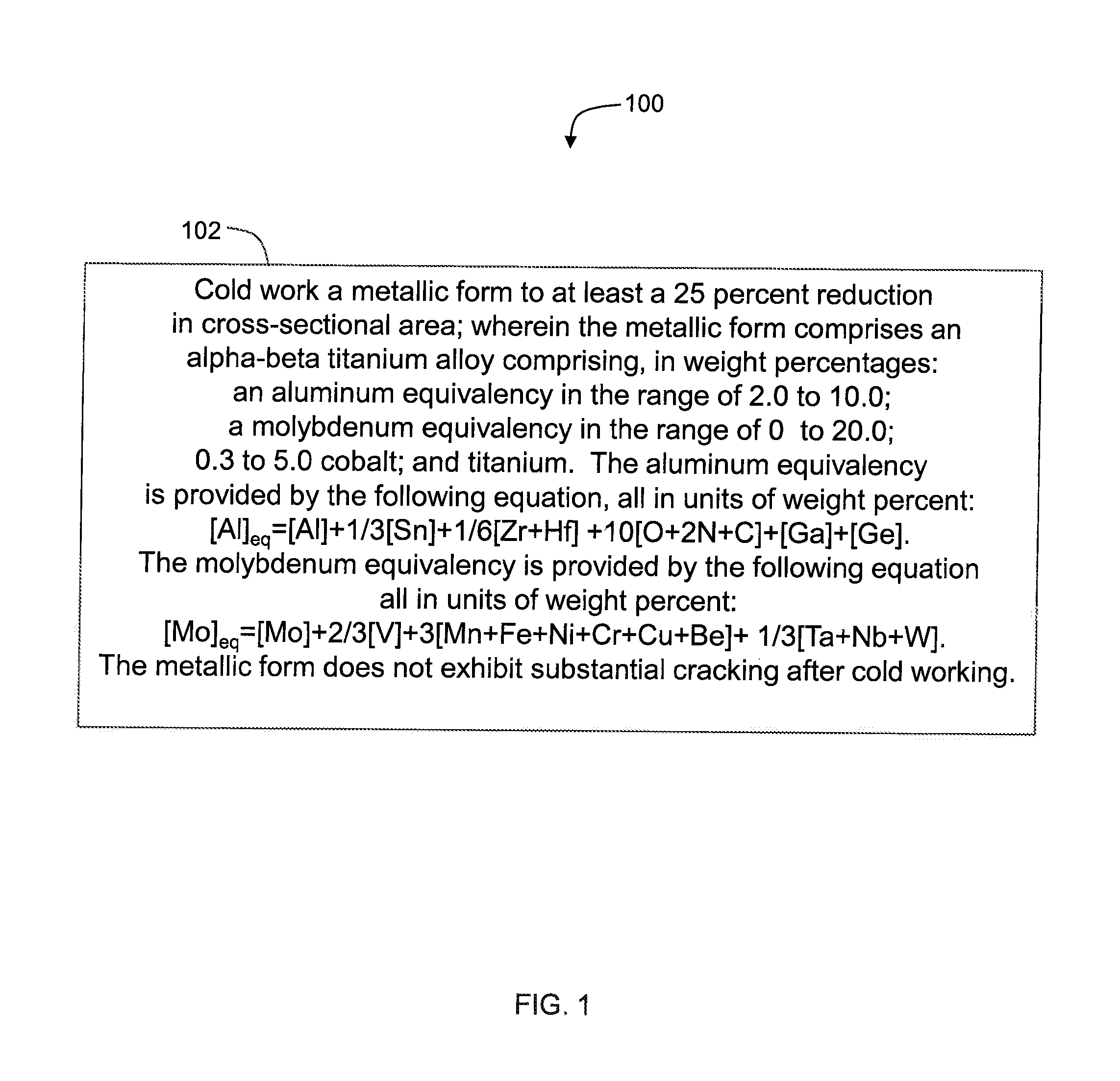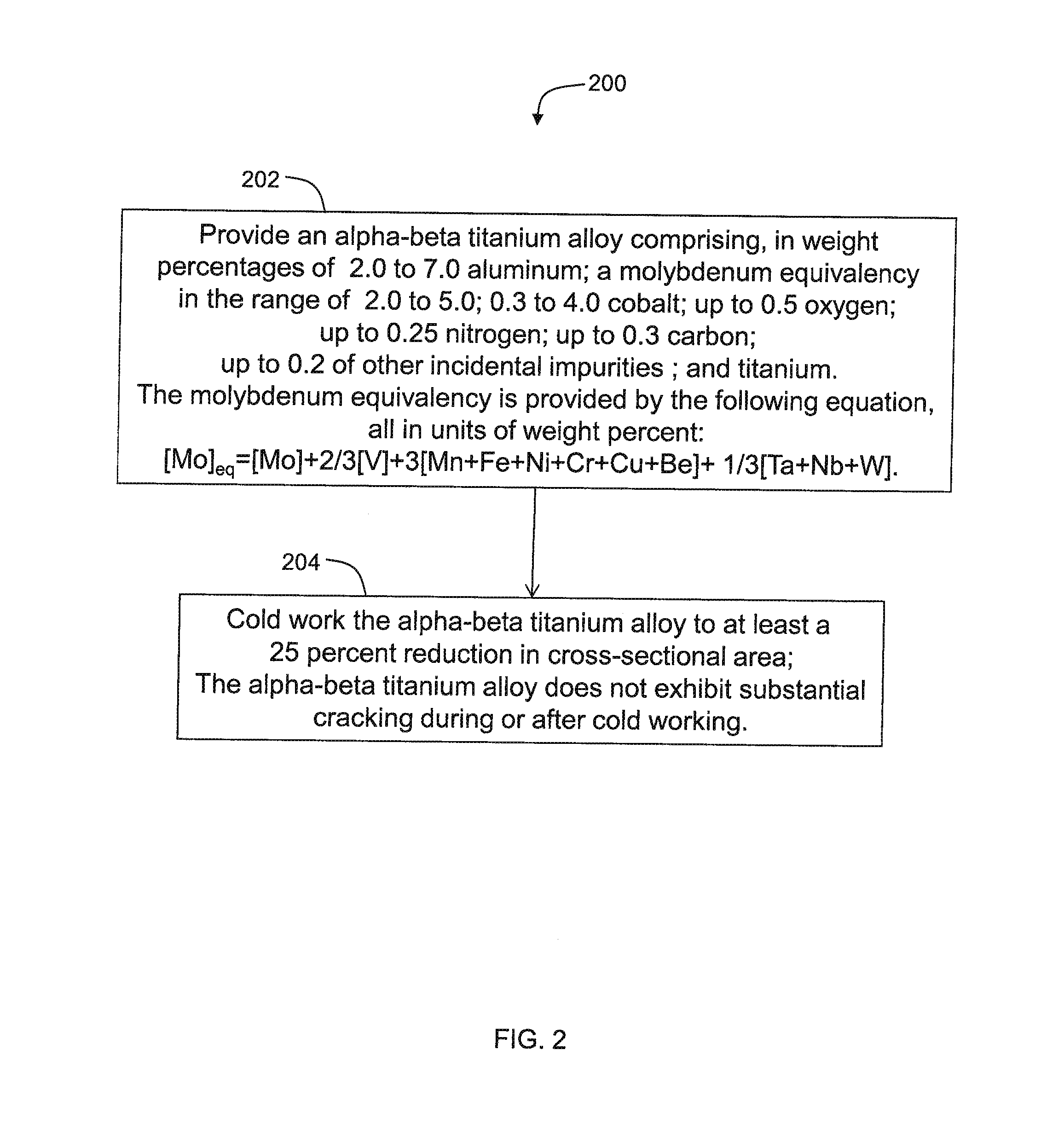Titanium alloy
a titanium alloy and alphabet technology, applied in the field of high-strength alphabeta titanium alloys, can solve the problems of limiting the acceptance of low-temperature processing, reducing the degree of ductility of titanium alloys that exhibit room temperature ductility, and reducing the degree of ductility of titanium alloys
- Summary
- Abstract
- Description
- Claims
- Application Information
AI Technical Summary
Benefits of technology
Problems solved by technology
Method used
Image
Examples
example 2
[0086]The mechanical performance of a second alloy (Heat 5) within the scope of the present disclosure was compared with a small coupon of Ti-4Al-2.5V alloy. Table 2 lists the composition of Heat 5 and, for comparison purposes, the composition a heat of a Ti-4Al-2.5V (which lacks Co). The compositions in Table 2 are provided in weight percentages.
TABLE 2YSUTSAlloyAlVOFeCoC(ksi)(ksi)% El.Ti—4Al—2.5V4.12.60.241.530.00.01401544Heat 53.62.70.260.850.950.0515016216
[0087]Buttons of Heat 5 and the comparative Ti-4Al-2.5V alloy were prepared by melting, hot rolling, and then cold rolling in the same manner as the cobalt-containing alloy of Example 1. The yield strength (YS), ultimate tensile strength (UTS), and percent elongation (% El.) were measured according to ASTM E8 / E8M-13a and are listed in Table 2. Neither alloy exhibited cracking during the cold rolling. The strength and ductility (% El.) of the Heat 5 alloy exceeded those of the Ti-4Al-2.5V button.
example 3
[0088]The cold rolling capability, or the reduction ductility limit, was compared based on alloy composition. Buttons of alloy Heats 1-4 were compared with a button having the same composition as the Ti-4Al-2.5V alloy used in Example 2. The buttons were prepared by melting, hot rolling, and then cold rolling in the manner used for the cobalt-containing alloy of Example 1. The buttons were cold rolled until substantial cracking was observed. Table 3 lists the compositions (remainder titanium and incidental impurities) of the inventive and comparative buttons, in weight percentages, and the cold working reduction ductility limit expressed in percent reduction of the hot rolled buttons.
TABLE 3ColdReductionButtonDuctilityHeat No.AlZrOVNbCrFeCoSiLimit (%)Heat 13.65.10.303.30001053Heat 23.55.10.302.12.6001051Heat 33.800.303.800010.162Heat 43.800.3000201.6055Ti—4Al—2.5V4.100.242.6001.530040
[0089]From the results in Table 3, it is observed that higher oxygen content is tolerated without los...
PUM
| Property | Measurement | Unit |
|---|---|---|
| Temperature | aaaaa | aaaaa |
| Temperature | aaaaa | aaaaa |
| Temperature | aaaaa | aaaaa |
Abstract
Description
Claims
Application Information
 Login to View More
Login to View More - R&D
- Intellectual Property
- Life Sciences
- Materials
- Tech Scout
- Unparalleled Data Quality
- Higher Quality Content
- 60% Fewer Hallucinations
Browse by: Latest US Patents, China's latest patents, Technical Efficacy Thesaurus, Application Domain, Technology Topic, Popular Technical Reports.
© 2025 PatSnap. All rights reserved.Legal|Privacy policy|Modern Slavery Act Transparency Statement|Sitemap|About US| Contact US: help@patsnap.com


